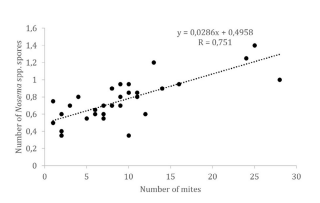Infestation levels of Varroa destructor and Nosema spp. in africanized bee (Apis mellifera) colonies during the dry season in the semiarid region of Piauí State
DOI:
https://doi.org/10.21708/avb.2022.16.1.10428Resumen
This study aimed to assess infestation levels of the mite Varroa destructor and microspore Nosema spp. in apiaries in the Picos microregion of Piauí state, Brazil, during the dry season. To that end, bees were collected (n=31) from 19 apiaries between September and October 2016. Infestation levels of the parasites were analyzed at the Laboratory of the Bee Technology Center, an institution affiliated with the Senador Helvídio Nunes de Barros Campus of the Federal University of Piauí. Varroa destructor was identified in 54% of the colonies, with infestation levels varying from 0 to 10.54%, and an average of 3.31% ± 4.12. Analysis of Nosema spp. revealed that all the colonies sampled exhibited microsporidia, albeit at low (1 to 1.4 spores/bee) and very low levels (0.35 to 0.95 spores/bee) of infestation. Given the relevance of beekeeping in the semiarid region of Piauí, it was concluded that although infestation levels were deemed low, there is a need to regularly monitor the health of colonies in the apiaries.
Descargas

Descargas
Publicado
Número
Sección
Licencia
Autores que publicam na Acta Veterinaria Brasilica concordam com os seguintes termos: a) Autores mantém os direitos autorais e concedem à revista o direito de primeira publicação, com o trabalho simultaneamente licenciado sob a Licença Creative Commons Attribution que permite o compartilhamento do trabalho com reconhecimento da autoria e publicação inicial nesta revista. b) Autores têm autorização para assumir contratos adicionais separadamente, para distribuição não-exclusiva da versão do trabalho publicada nesta revista (ex.: publicar em repositório institucional ou como capítulo de livro), com reconhecimento de autoria e publicação inicial nesta revista. c) Autores têm permissão e são estimulados a publicar e distribuir seu trabalho online (ex.: em repositórios institucionais ou na sua página pessoal) a qualquer ponto antes ou durante o processo editorial, já que isso pode gerar alterações produtivas, bem como aumentar o impacto e a citação do trabalho publicado (Veja O Efeito do Acesso Livre).


 Esta obra está licenciada com uma Licença
Esta obra está licenciada com uma Licença 